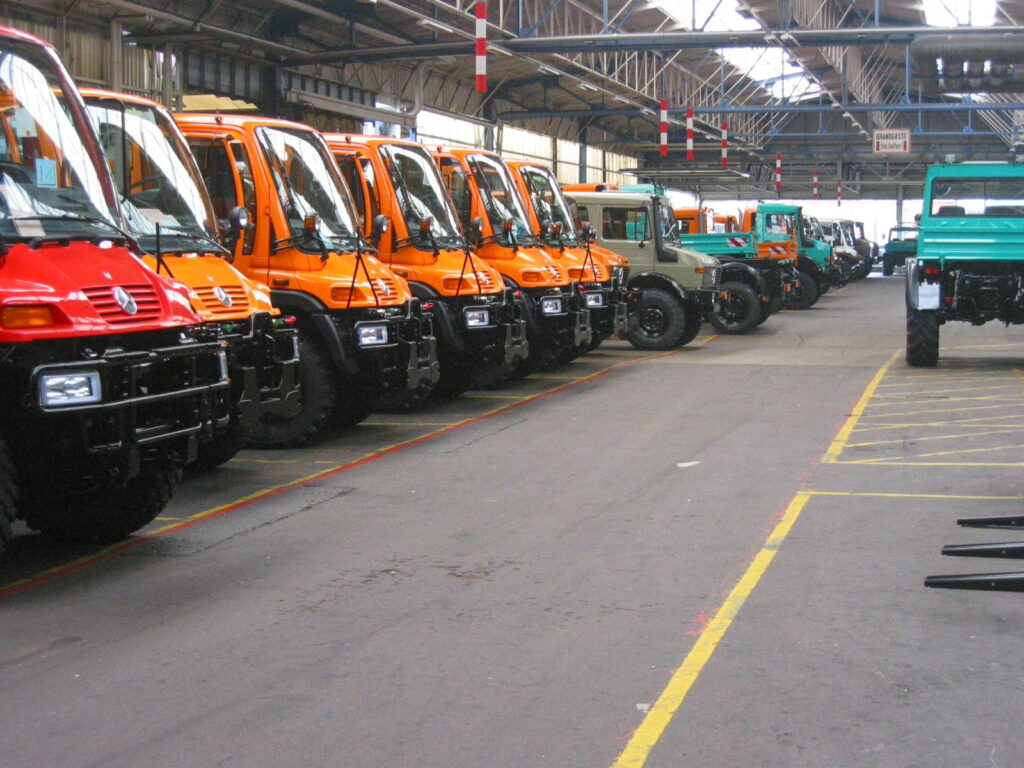
Hier sind noch die letzten in Gaggenau montierten Unimog zu sehen. Here you can still see the last Unimog assembled in Gaggenau. Foto Carl-Heinz Vogler
See English text below
Nach 51 Jahren der Produktion des Unimog im Mercedes-Benz Werk Gaggenau wurde er im August 2002 in das Lkw-Werk Wörth verlagert. Am 26. August 2002 – also vor 20 Jahren – liefen die dort deren erste Unimog vom Band. Zuvor war am 2. August der letzte Gaggenauer Unimog montiert worden.
1951 kam der Unimog von Boehringer in Göppingen, wo die ersten 602 Unimog gebaut worden waren, in das Murgtal. Mit dabei auch einige Mitarbeiter. „Unimog isch Gaggenau und Gaggenau isch Unimog“ wurde immer wieder mal gesagt, denn neben Luxusküchen mit gleichem Namen wurde Gaggenau so in aller Welt bekannt. Der Unimog entwickelte sich zum Kultfahrzeug und brachte es im besten Jahr auf über 10.000 Einheiten. Geringere Nachfrage des Militärs, veränderte Anforderungen in der Landwirtschaft und Zurückhaltungen kommunaler Auftraggeber führten aber zu geringen Jahresproduktionen. Die Suche nach einem Kooperations- oder gar Übernahmeunternehmen war erfolglos.
In einem beispielhaften Beteiligungsprozess wurden 2001 die Mitarbeiter zur beabsichtigten Verlagerung des Unimog in das Schwesterwerk Wörth befragt. Die Vorteile waren so eindeutig, dass 92,2 % der Belegschaft dieses Vorhaben für richtig einstuften. Das sollte sich in den Folgejahren zusätzlich bestätigen, denn die Jahresproduktion fiel weiter. Niemand hätte eine Fortsetzung der Produktion ernsthaft fordern können. Doch da wurde im Schweizer Saurer-Werk in Arbon die weitere Montage des Econic kurzfristig eingestellt. Es gelang, diese zusätzlich auf das Unimog-Montageband zu legen. Der Unimog überlebte dadurch.
Im Werk Gaggenau wurden durch die Verlagerung des Unimog dringend benötigte wertvolle Flächen für die Erweiterung der Wandler- und Getriebefertigung frei. Auch das erwies sich in der Folgezeit als vorteilhaft.
Heute erinnert das 2006 eingeweihte Unimog-Museum an die Erfolgsgeschichte des Unimog in Gaggenau. Es ist aufgrund der Besucherzahlen und des Engagements vieler ehrenamtlicher Helferinnen und Helfer auch selbst eine Erfolgsgeschichte, und so wird Ende diesen Jahres der Erweiterungsbau in Betrieb genommen werden können. Damit verdoppelt sich die Ausstellungsfläche und es können auf einer Sonderfläche auch einige Exponate aus der über 125jährigen Gaggenauer Automobilgeschichte gezeigt werden. Schließlich ist das Werk Gaggenau das älteste Automobilwerk der Welt am gleichen Standort. Gelegentlich wird entgegengehalten, dass doch die von Gottlieb Daimler und Karl Benz gegründeten Werke älter sein müssten. Doch diese Werke zogen kurz nach ihrer Gründung um.
Michael Wessel – 26. August 2022
20 years ago the first Wörth Unimog was built
After 51 years of production of the Unimog at the Mercedes-Benz plant in Gaggenau, it was transferred to the Wörth truck plant in August 2002. On 26 August 2002 – 20 years ago – the first Unimogs rolled off the production line there. Before that, the last Gaggenau Unimog had been assembled on 2 August.
In 1951, the Unimog came to the Murg valley from Boehringer in Göppingen, where the first 602 Unimogs had been built. Along with them were some of the employees. “Unimog isch Gaggenau und Gaggenau isch Unimog” was said time and again, because alongside luxury kitchens with the same name, this is how Gaggenau became known all over the world. The Unimog developed into a cult vehicle and in its best year produced over 10,000 units. However, lower demand from the military, changing requirements in agriculture and restraint on the part of municipal clients led to low annual production. The search for a cooperation or even a takeover company was unsuccessful.
In 2001, in an exemplary participation process, the employees were asked about the intended relocation of the Unimog to the sister plant in Wörth. The advantages were so clear that 92.2 % of the workforce thought this was the right thing to do. This was to be further confirmed in the following years, as annual production continued to fall. No one could have seriously demanded a continuation of production. But then, at the Swiss Saurer plant in Arbon, further assembly of the Econic was stopped at short notice. It was possible to put it on the Unimog assembly line in addition. As a result, the Unimog survived.
At the Gaggenau plant, the relocation of the Unimog freed up urgently needed valuable space for the expansion of converter and transmission production. This, too, proved to be advantageous in the period that followed.
Today, the Unimog Museum, inaugurated in 2006, is a reminder of the Unimog’s success story in Gaggenau. It is also a success story in its own right, thanks to the number of visitors and the commitment of many volunteers, and the extension building will be ready for use at the end of this year. This will double the exhibition space and a special area will also be able to display some exhibits from Gaggenau’s more than 125 years of automotive history. After all, the Gaggenau plant is the world’s oldest car factory at the same location. Occasionally it is argued that the factories founded by Gottlieb Daimler and Karl Benz must be older. But these plants moved shortly after they were founded.

